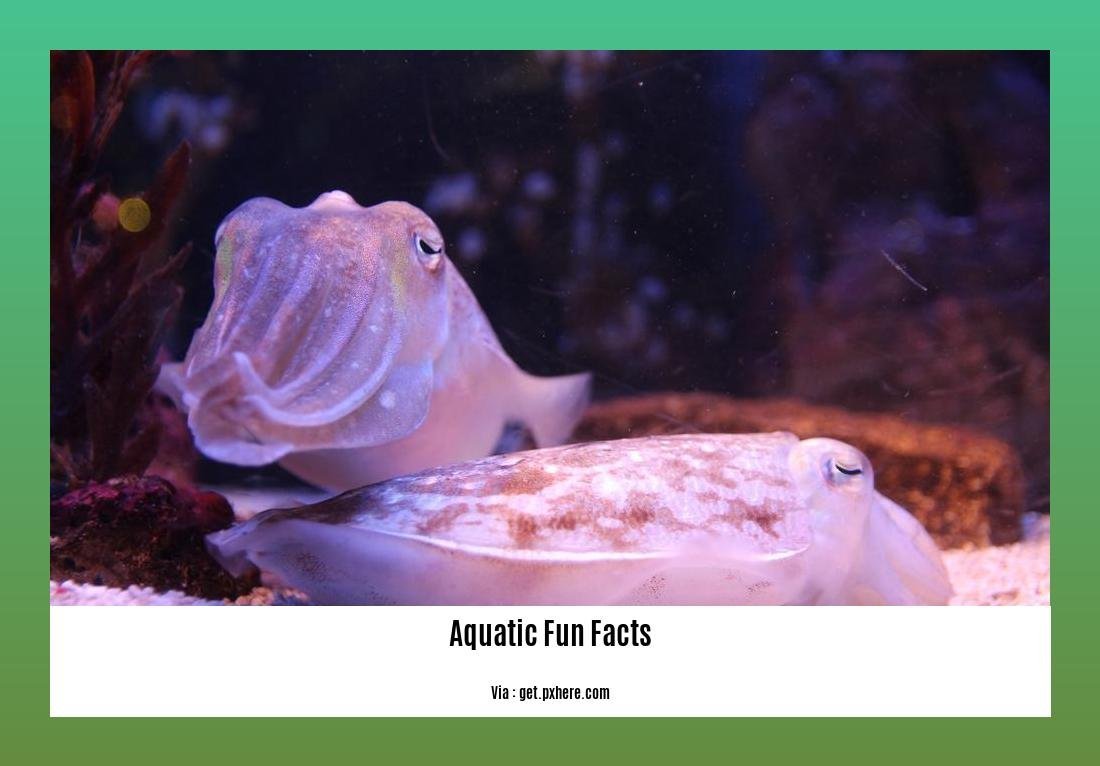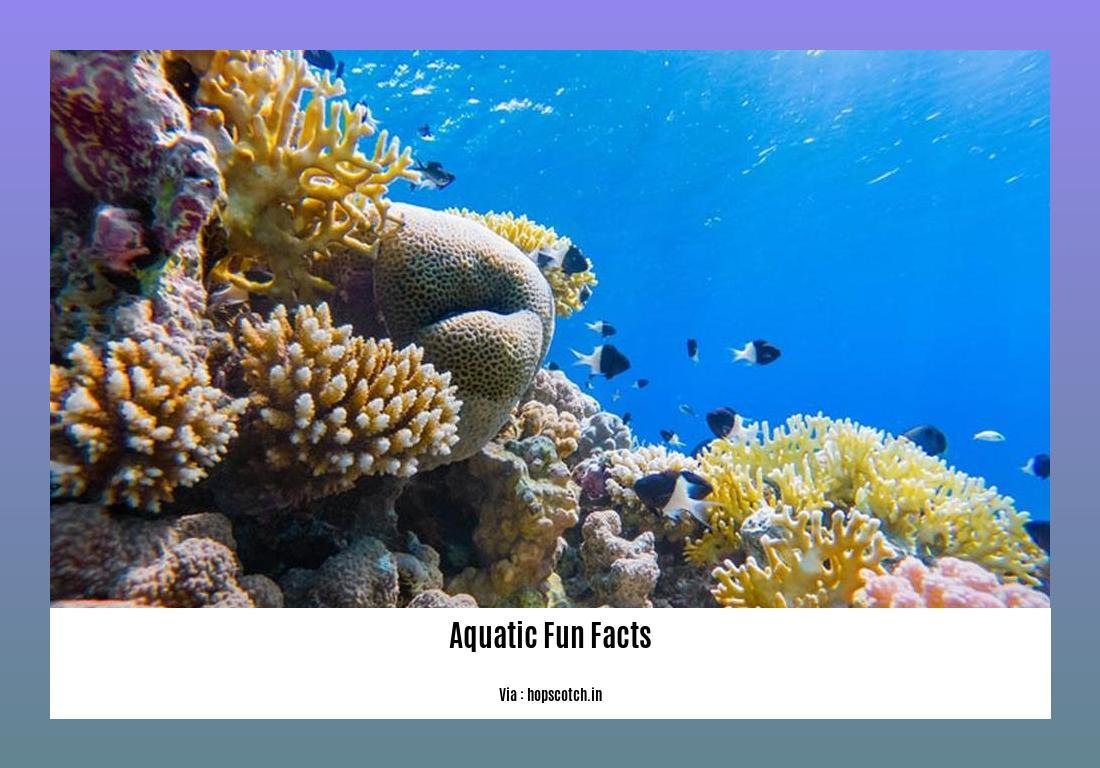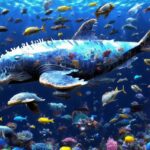Welcome to a captivating journey into the world of aquatic fun facts! In this article, titled “Dive into Delights: Exploring Aquatic Fun Facts with a Marine Biologist,” we invite you to join us as we delve deep beneath the surface of our oceans, rivers, and lakes. Prepare to be amazed by the extraordinary phenomena, surprising behaviors, and astonishing adaptations that the marine world has to offer. With the expertise of a seasoned marine biologist, we will guide you through a mesmerizing exploration of the hidden wonders that exist in the aquatic realm. Get ready to immerse yourself in a treasure trove of intriguing insights that promise to educate and entertain – an experience you won’t want to miss!
Key Takeaways:
- Seahorses are unique in that the males give birth and care for their young.
- Shrimps have their hearts located in their heads.
- Sea sponges are living creatures despite lacking organs such as a head, mouth, eyes, and brain.
- Turtles can be found on every continent except Antarctica.
- The ocean covers approximately 70% of the Earth’s surface.
- The Pacific Ocean is the largest ocean, covering about 30% of the Earth’s surface.
- The Mariana Trench is known as the deepest area in the Earth’s oceans.
- Nearly 95% of all life on the planet resides in the ocean.
Aquatic Fun Facts

As a marine biologist, I’ve had the privilege of diving into the depths of underwater ecosystems and uncovering some incredible aquatic fun facts. Join me on this adventure as we explore the mesmerizing world beneath the surface and discover extraordinary phenomena, surprising behaviors, and astonishing adaptations.
1. Seahorses: The Exceptional Fathers of the Ocean
Did you know that seahorses are the only animals in which the male, not the female, gives birth and cares for their young? It’s true! Male seahorses have a special pouch where they carry their eggs until they hatch. Once the babies emerge, the males continue to provide protection and even nourishment by pumping nutrients into their offspring.
2. Shrimp: A Heart in the Head
Here’s a quirky fact: a shrimp’s heart is located in its head! While it may sound strange, this unique positioning allows for efficient oxygen delivery throughout their bodies. It’s just one of the many oddities that make marine life so fascinating.
3. Sea Sponges: Brains Without Brains
Sea sponges are some of the simplest creatures found in the ocean. They have no head, mouth, eyes, feelers, bones, heart, lungs, or brain, yet they are indeed alive. These incredible organisms survive by filtering water through their bodies, extracting nutrients and oxygen as they go. It’s a remarkable example of how life can thrive even without complex structures.
4. Turtles: A Global Presence
Turtles are some of the most iconic creatures in the aquatic world, and did you know they live on every continent except Antarctica? Whether it’s the majestic sea turtles swimming through the crystal-clear waters of tropical beaches or the hardy freshwater turtles basking in the sun by rivers and lakes, these ancient reptiles have carved out a place for themselves in diverse habitats worldwide.
5. The Ocean: A Vast Universe Beneath the Waves
The ocean covers approximately 70% of our planet’s surface, making it the largest habitat on Earth. Its vastness is just one of the reasons why exploration of the depths continues to fill us with awe and wonder. From vibrant coral reefs teeming with life to the mysterious abyssal plains where unique and elusive creatures lurk, the ocean offers endless opportunities for discovery and adventure.
6. The Pacific Ocean: A Titan Amongst Waters
When it comes to oceans, the Pacific takes the crown as the largest on Earth, covering around 30% of the planet’s surface. Spanning from the western coast of the Americas to the eastern shores of Asia and Australia, this vast expanse of water is home to countless species and diverse ecosystems. Its sheer size and power are a testament to the grandeur of our planet’s natural wonders.
7. The Mariana Trench: Exploring Earth’s Deepest Depths
Did you know that the Mariana Trench is the deepest known area in the Earth’s oceans? This incredible trench, located in the western Pacific Ocean, reaches a staggering depth of around 36,000 feet (10,972 meters). To put it into perspective, if Mount Everest, the tallest peak on land, were placed into the Mariana Trench, it would still be submerged by more than a mile of water. The mysteries that lie within this deep sea chasm continue to fascinate and challenge our understanding of the underwater world.
8. The Ocean: A Sanctuary for Life
The ocean is not only a vast expanse of water; it is also a sanctuary for an incredible array of creatures. In fact, nearly 95 percent of all life on Earth resides within its depths. From tiny plankton to massive whales, the ocean supports a delicate and interconnected web of life, playing a vital role in the health of our planet. It’s a reminder of just how interconnected our world truly is.
Are you amazed by these aquatic fun facts? They only scratch the surface of the wonders waiting to be discovered in the underwater realm. So dive in, embrace your curiosity, and let the enchanting world of aquatic life captivate your imagination. There’s always something new and exciting to learn about the creatures that call the watery depths their home.
Here are some fascinating facts about animal care:
- Animal care facts: Did you know that proper animal care is crucial for their well-being? Discover interesting facts about how to take care of animals and create a nurturing environment for them.
Learn about the mesmerizing Arctic Willow:
- Arctic willow facts: Uncover the secrets of the Arctic Willow, a unique plant that thrives in cold and harsh environments. Explore its adaptations and discover why it’s a testament to nature’s resilience.
Have you ever wondered if African wild dogs are related to dogs?
- Are African wild dogs related to dogs: Dive into the world of African wild dogs and find out if they share any familial ties with domestic dogs. Delve into their evolutionary history and learn about the captivating similarities and differences.
Curious about the connection between African wild dogs and hyenas?
- Are African wild dogs related to hyenas: Explore the intriguing relationship between African wild dogs and hyenas. Discover how these two unique predators interact and compete in the wild, unraveling the fascinating dynamics of African ecosystems.
The Art of Underwater Communication: How Marine Animals Use Sounds, Colors, and Movements
Underwater communication is a mesmerizing aspect of marine life that allows species to interact, navigate their environment, find mates, and avoid predators. From dolphins and whales to fish and sharks, marine animals have developed unique ways of communicating beneath the surface. In this article, we will explore the fascinating world of underwater communication and discover how marine animals use sounds, colors, and movements to convey messages.
Sounds: The Language of the Ocean
Sound is a powerful tool for communication in the underwater realm. Marine mammals, in particular, heavily rely on sound to communicate with each other. For millions of years, they have evolved to use underwater sound as their primary means of communication and assessing their environment[^1^].
Marine mammals produce a wide range of vocalizations, including clicks, whistles, and songs. These acoustic signals serve various purposes, such as establishing their identity, coordinating group activities, and transmitting important information[^3^]. Each individual or group has its own unique vocalizations, allowing them to identify one another and maintain social structure.
But it’s not just marine mammals that use sound for communication. Fish also produce sounds using specialized structures known as swim bladders. These sounds can serve purposes like attracting mates, defending territories, and alerting others to potential threats[^4^].
Unfortunately, the increasing presence of anthropogenic noise in the ocean poses significant challenges for marine animals. Human-generated sounds such as shipping, sonar, and seismic exploration can interfere with underwater communication. This interference could jeopardize marine animals’ ability to find mates or food if their communication calls are masked by the anthropogenic noise[^5^].
To better understand underwater communication and its effects on marine animals, organizations like NOAA Fisheries use various technologies to record ocean sounds. These recordings help scientists study how marine animals perceive and respond to their acoustic environment[^6^].
Colors: Visual Signals Beneath the Waves
While sound is critical for many marine animals, some species also rely on colors as a form of communication. Vibrant hues and patterns can convey important messages in the underwater realm.
For example, many fish use bright colors to attract mates or intimidate rivals. The peacock mantis shrimp, with its dazzling display of colors, signals dominance or territorial ownership. Some species of octopus can change their color and patterns to blend into their surroundings or communicate their mood[^7^].
Cooperative hunting is another fascinating behavior that relies on visual signals. Certain species of dolphins display coordinated movements and create bubble nets to corral fish, indicating their intent to hunt. This visual communication among group members ensures successful collaboration in capturing prey.
Movements: The Dance of Marine Life
Movements also play a crucial role in underwater communication. By observing the movements of marine animals, we can decipher their intentions, emotions, and even warnings.
Consider the graceful dance of a sea turtle. When mating, female sea turtles approach males with a specific swimming pattern, signaling their readiness to reproduce. Male cuttlefish, on the other hand, engage in elaborate courtship displays involving colorful body patterns and mesmerizing movements to attract females[^8^].
In the vast expanse of the ocean, precise movements are essential for survival. Schools of fish expertly coordinate their swimming patterns, creating stunning visual displays while simultaneously enhancing their ability to evade predators. These synchronized movements allow them to navigate obstacles and communicate important information, such as the presence of food or danger.
Understanding the intricacies of underwater communication is vital for the conservation and protection of marine species. Efforts to reduce anthropogenic noise and preserve acoustic habitats are necessary to ensure the survival and well-being of these incredible animals.
Key Takeaways:

- Marine animals, particularly mammals, heavily rely on sound for communication in the underwater realm.
- Vocalizations, such as clicks, whistles, and songs, allow marine mammals to establish identity, coordinate group activities, and transmit information.
- Fish also use sound for communication, producing sounds with swim bladders to attract mates, defend territories, and alert others to potential threats.
- Anthropogenic noise, generated by human activities, can interfere with underwater communication and impact marine animals’ ability to find mates or food.
- Colors serve as visual signals for many marine species, conveying information about mating, dominance, territorial ownership, or mood.
- Movements play a crucial role in underwater communication, allowing animals to convey intentions, emotions, warnings, and coordinate activities.
Sources:
By delving into the fascinating world of underwater communication and exploring how marine animals use sounds, colors, and movements, we gain a deeper appreciation for the complex and beautiful realm beneath the waves. Join me on this immersive journey into the aquatic realm, where surprising behaviors and astonishing adaptations await discovery.
Mind-boggling adaptations: Extraordinary features that help aquatic species thrive
Underwater ecosystems are teeming with incredible creatures that have adapted to their unique environments in ingenious ways. These mind-boggling adaptations enable aquatic species to thrive and survive in the depths of our oceans, rivers, and lakes. Join me on a journey to explore the extraordinary features that make these species so fascinating.
Blending In: Camouflage Techniques that Defy Detection
Many aquatic species have developed remarkable camouflage techniques to hide from predators or ambush their prey. From the mesmerizing colors of coral reef fish to the perfectly disguised bodies of seahorses, aquatic creatures have mastered the art of blending in.
One remarkable example of aquatic camouflage is the mimic octopus. This cephalopod has the incredible ability to mimic the appearance and behavior of other creatures, such as toxic lionfish or poisonous sea snakes. By morphing its shape, texture, and color, the mimic octopus can deceive both predators and prey.
Did you know? The mimic octopus can imitate up to 15 different species, making it a true master of disguise. Its extraordinary adaptability allows it to survive in various marine environments.
Sensational Senses: Unconventional Ways of Perception
Aquatic species have evolved astonishing sensory abilities that allow them to perceive their surroundings in unconventional ways. These sensory adaptations provide them with a distinct advantage in their underwater habitats.
Take the electric eel, for instance. This remarkable creature has the ability to generate and detect electric currents. Through specialized organs called electrocytes, the electric eel can produce electric shocks to navigate, hunt, and communicate with other eels.
Mind-boggling Adaptation Alert! The electric eel can generate shocks of up to 600 volts, which is more than five times the voltage of a standard power socket. This adaptation allows it to stun prey and deter predators.
Extreme Survivors: Unparalleled Resistance to Harsh Conditions
Aquatic species often face extreme environmental conditions, such as freezing temperatures, high pressure, or complete darkness. To thrive in these challenging circumstances, they have developed extraordinary adaptations that push the limits of survival.
Enter the Antarctic icefish, a species that defies the odds by having transparent blood and no hemoglobin. Hemoglobin is responsible for carrying oxygen in the blood, but in the icefish’s unique case, the lack of it allows the blood to transport more oxygen, making up for the cold and oxygen-depleted waters of Antarctica.
Mind-boggling Adaptation Alert! The Antarctic icefish’s adaptation to its icy habitat is so extreme that it cannot survive in warmer waters due to the rapid increase in metabolic demand.
Master Architects: Ingenious Structures for Survival
Some aquatic species showcase incredible architectural skills, constructing intricate structures that serve as shelter, hunting grounds, or nurseries. These structures demonstrate their resourcefulness and adaptability to their surroundings.
The pufferfish is one such master architect. When threatened, it inflates its body, transforming from a small, vulnerable fish into a much larger, spiky ball of protection. This adaptation deters predators and keeps the pufferfish safe from harm.
Did you know? The pufferfish’s amazing ability to inflate is thanks to an elastic stomach that can rapidly expand with water or air. This defense mechanism is just one example of the extraordinary adaptations found in the aquatic world.
Key Takeaways:
- Aquatic species have evolved mind-boggling adaptations to thrive in their unique environments.
- Camouflage techniques allow aquatic creatures to blend in seamlessly with their surroundings.
- Sensory adaptations give aquatic species an edge in perceiving their environment in unconventional ways.
- Some aquatic species exhibit unparalleled resistance to extreme conditions, such as freezing temperatures or complete darkness.
- Master architects in the aquatic world build intricate structures to serve as shelter, hunting grounds, or nurseries.
Sources:
- SmithsonianMag: Five Amazing Adaptations That Help Animals Thrive in the Dark
- Carnegie Museum of Natural History: Survival of the Fishiest: Astonishing Adaptations of the Aquatic World
Curious behaviors: Surprising and fascinating habits of underwater creatures
Underwater creatures never cease to amaze us with their curious behaviors and surprising habits. From unusual communication methods to unique adaptations, the aquatic realm is full of captivating wonders. Join me as we dive into the mesmerizing world beneath the surface and explore the extraordinary phenomena that unfold.
The Hidden Art of Underwater Communication: Secrets of Marine Species
Underwater communication is an essential aspect of marine life, enabling species to navigate, find mates, and stay safe. From whales and dolphins to fish and sharks, marine animals have developed fascinating ways to communicate with each other.
One key element of underwater communication is sound. Marine mammals, such as dolphins and whales, rely heavily on sound to interact and navigate their environment. Each individual produces distinct vocalizations and group calls, allowing them to establish identity, coordinate activities, and transmit crucial information. Other aquatic animals, like fish, use specialized structures called swim bladders to produce sound, serving purposes such as finding mates, defending territories, and alerting others to threats.
However, the presence of anthropogenic noise, generated by human activities like shipping and sonar, poses a significant challenge. This noise can interfere with underwater communication, making it difficult for marine animals to hear important calls from their counterparts. Efforts to reduce anthropogenic noise and preserve acoustic habitats are crucial for the survival and well-being of marine species.
Source:
– Discovery of Sound in the Sea – Marine Mammal Communication
– Ocean Noise | NOAA Fisheries
Five Amazing Adaptations That Help Animals Thrive in the Dark
The dark depths of the ocean and other perpetually dark environments present unique challenges for animals. However, these challenging conditions have led to fascinating adaptations that help them not only survive but thrive in the darkness.
- Owls: These nocturnal predators have incredibly sensitive hearing, allowing them to pinpoint their prey in the dark. Their ability to fly silently enhances their hunting success.
- Bats: While bats can see well in low light, they also rely on soundwaves for socializing and navigating. Through echolocation, they emit high-pitched sounds and listen for the echoes, creating a detailed sonic map of their surroundings.
- Ogre-faced spiders: Thanks to their large eyes, these spiders have excellent vision even in the darkest environments. They can sense vibrations and detect sound waves, giving them a sensory advantage.
- Snakes: Certain snake species, like pit vipers, pythons, and boas, can see in infrared. This adaptation allows them to detect the heat emitted by potential prey, giving them a distinct advantage in hunting.
These remarkable adaptations highlight the incredible diversity of strategies animals have developed to conquer the challenges of darkness.
Sources:
– SmithsonianMag: Five Amazing Adaptations That Help Animals Thrive in the Dark
– Carnegie Museum of Natural History: Survival of the Fishiest: Astonishing Adaptations of the Aquatic World
Key Takeaways:
- Underwater communication plays a vital role in the survival and behavior of marine species.
- Sound is a crucial medium for communication among marine mammals and some fish species.
- Anthropogenic noise poses challenges for underwater communication and the well-being of marine animals.
- Adaptations like sensitive hearing, echolocation, and infrared vision enable animals to thrive in dark environments.
FAQ
Q1: What is the significance of underwater communication in marine life?
A1: Underwater communication plays a crucial role in the survival and behavior of many marine species. It helps them navigate their environment, find mates, and avoid predators.
Q2: How do marine mammals use sound for communication?
A2: Marine mammals, such as dolphins and whales, have evolved over millions of years to use underwater sound as their primary means of communication. They produce individual-specific vocalizations and group calls, such as clicks, whistles, and songs, to establish their identity, coordinate activities, and transmit important information.
Q3: How do fish communicate underwater?
A3: Fish utilize specialized structures called swim bladders to produce sounds. These sounds serve various purposes, including attracting mates, defending territories, and alerting others to potential threats.
Q4: What is anthropogenic noise, and how does it affect marine animals?
A4: Anthropogenic noise refers to human-generated sounds, such as shipping, sonar, and seismic exploration, that can interfere with underwater communication. If communication sounds are masked by anthropogenic noise, marine animals may not hear calls from others, jeopardizing their ability to find mates or food.
Q5: Why is understanding underwater communication important for the conservation of marine species?
A5: Understanding underwater communication is crucial for the conservation and protection of marine species. Efforts to reduce anthropogenic noise and preserve acoustic habitats are necessary to ensure the survival and well-being of these animals.
- Prevent Free Surface Effect: Ship Stability Guide - April 15, 2025
- Soccer Team Size: Official Rules & Player Counts (2025) - April 15, 2025
- Red Cloud, NE: Discover Willa Cather’s Legacy - April 11, 2025
















